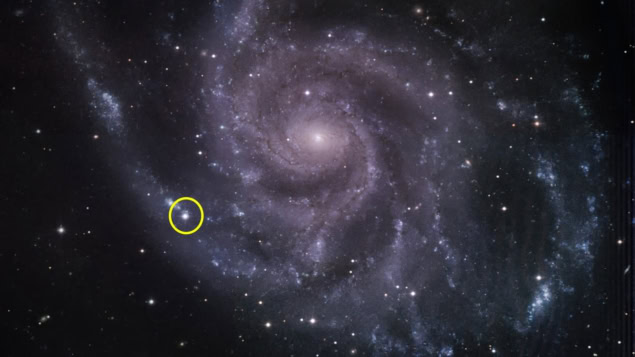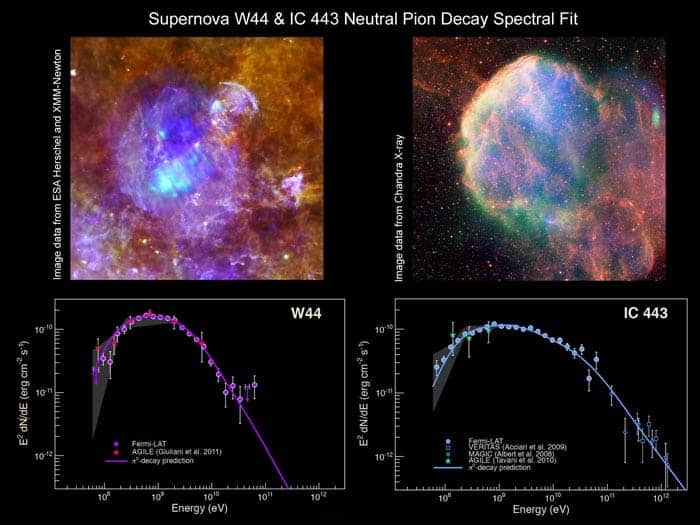
The lack of observed gamma rays from a recent supernova has cast doubt on the generally-accepted idea that exploding stars are a major source of cosmic rays. The observation was made using NASA’s Fermi Gamma-ray Space Telescope.
Cosmic rays are high-energy charged particles (mostly protons) that arrive at Earth from beyond the solar system. Their exact origins are a long-standing mystery because their trajectories are deflected by the magnetic fields that they encounter along the way.
The particle’s high energies suggest that they are born in violent astrophysical events such as supernovae (exploding stars) – a theory first proposed 90 years ago.
“This idea has been very successful in explaining cosmic rays within the Milky Way,” explains Guilleme Martí-Devesa at the University of Trieste, Italy, who led the research. “However, it has been seriously challenged by observational data in the last two decades.”
Gamma-ray clues
High-energy protons from supernovae are expected to create gamma rays, which do travel in straight lines and therefore offer ways of determining the origins of cosmic rays. In 2013, the Fermi telescope observed two remnants of nearby supernovae that exploded more than 10,000 years ago.
These objects have blast waves and expanding clouds of debris that are expected to create cosmic rays. Indeed, the observed gamma-ray spectra of the objects matched that expected if high-energy protons were colliding with debris to produce pions – which then decay to produce distinctive gamma rays.
While this provides evidence that cosmic rays are produced by supernovae, the gamma-ray observations suggest a much lower rate of production than is needed to explain the cosmic-ray flux impinging on Earth. In particular, the 2013 study could not explain the observed the abundance of particles with petaelectronvolt energies, which are close to the middle of the cosmic-ray energy spectrum.
One explanation of this shortcoming is that more cosmic rays are created in the days and weeks following the initial supernova explosion. Confirming this, however, would require a nearby star to explode.
“Unfortunately, supernova events are quite rare, and those detected with ease by optical telescopes in other galaxies are too far away for our most sensitive gamma-ray detectors,” Martí-Devesa explains.
Fortuitous explosion
But astronomers got lucky on 18 May 2023, when a star exploded in the nearby Pinwheel galaxy, which is about 21 million light–years away. Dubbed SN 2023ixf, the explosion was the brightest supernova ever observed by the latest generation of gamma-ray space telescopes – including Fermi.
This was the ideal opportunity to search for evidence of cosmic rays produced in the immediate aftermath of the explosion. However, what Martí-Devesa and colleagues observed was not what they had expected. They saw no relevant gamma rays.

Supernova origin of galactic cosmic rays confirmed
“When we attempted to model the underlying cosmic ray population, we found that no more than 1% of the supernova’s energy was used to accelerate cosmic rays,” Martí-Devesa recalls. “This was a surprise, as we expected it to be close to 10%.”
The result suggests that contrary to decades of predictions, early-stage supernovae may not be a primary source of cosmic rays – leaving a glaring gap in the cosmic ray spectrum. For Martí-Devesa and colleagues, there are several possible reasons for this negative result, which will all require further investigation.
“Perhaps our modelling approach was too unrealistic? Was this supernova peculiar in some way? Or are we looking at the wrong sources?” Martí-Devesa speculates. “We need to explore further the physics of supernova shocks, to see whether supernovae play or not the central role we thought for the origin of cosmic rays.”
The observations are described in Astronomy & Astrophysics.



